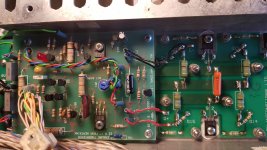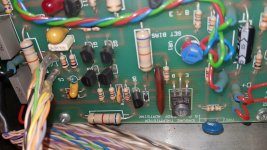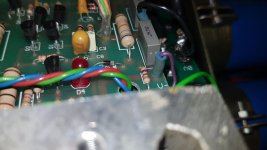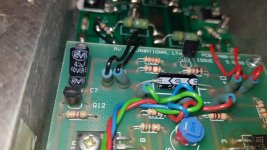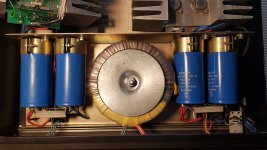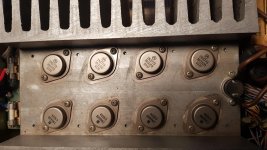Hi everyone.
For the last 30 years, I've been using a AVI S2000 HIGH POWER power amp. It has served me very well so far but I think it's time to give it some service and perhaps some upgrades. Besides power supply caps, and based on what I've read, I thought that the two tantalum caps located right after the input signal could be replaced as a sound upgrade. They are 10uf on the + and 100uf on the - both 6v. Given the limited space, what would you suggest ? Since there is a bias trimmer nearby, should there be any adjustments after cap replacement ? Also, any suggestions about other caps replacement. I'm an amateur but very cautious enthusiast and I'd really appreciate your advises. Photos are provided. Thank you.
For the last 30 years, I've been using a AVI S2000 HIGH POWER power amp. It has served me very well so far but I think it's time to give it some service and perhaps some upgrades. Besides power supply caps, and based on what I've read, I thought that the two tantalum caps located right after the input signal could be replaced as a sound upgrade. They are 10uf on the + and 100uf on the - both 6v. Given the limited space, what would you suggest ? Since there is a bias trimmer nearby, should there be any adjustments after cap replacement ? Also, any suggestions about other caps replacement. I'm an amateur but very cautious enthusiast and I'd really appreciate your advises. Photos are provided. Thank you.
Attachments
Any standard elco will do. These tantals are prone to sudden breakdown ending in a short circuit, so it is wise to replace them anyway. Despite the anecdotes published by the caps rollers here do not expect any sound difference - neither better - nor worse.
Tantalum caps are in the input because Low Leakage = Low Noise.
Since Tantalums are polarized, it can be changed only with Nichicon KL.
If you don't care about noise that will be amplified 63 times, (have no data so I guess that amp is 250W and input sensitivity is standard 0.7V), than bipolar caps would be good enough too.
By the way, why to fix good working amplifier...
Since Tantalums are polarized, it can be changed only with Nichicon KL.
If you don't care about noise that will be amplified 63 times, (have no data so I guess that amp is 250W and input sensitivity is standard 0.7V), than bipolar caps would be good enough too.
By the way, why to fix good working amplifier...
Btw, those unsafe and prone to sudden breakdown caps are in the few rovers on planet Mars right now 🙂
Good idea to lose those capacitors. High distortion a well. ticknpop has a good suggestion, but any good (not from Ebay) capacitor will do well there. Don't worry about noise, capacitors don't generate noise except for leakage - which is low in your application.
Current electrolytic capacitors have come a long way since your amplifier was built, plus designers have wised up to the high distortion they can create.
-Chris
Current electrolytic capacitors have come a long way since your amplifier was built, plus designers have wised up to the high distortion they can create.
-Chris
Btw, those unsafe and prone to sudden breakdown caps are in the few rovers on planet Mars right now 🙂
When I was designing electronics for a living, tantalum was not allowed in medical and avionics because of their unreliability.
If you really want to know more about caps in the signal path, do a search for the Cyril Bateman capacitor articles. Best that I know of.
Considers tant caps to be poor for just about any use where you don't need a large amount of capacitance for the size. Reliability for them is substandard and that is why most manufactures stopped using them. If you do use them, use a higher voltage rating to have some safety factor.
Cyril Bateman's Capacitor Sound articles | Linear Audio NL
Regards,
Greg
Considers tant caps to be poor for just about any use where you don't need a large amount of capacitance for the size. Reliability for them is substandard and that is why most manufactures stopped using them. If you do use them, use a higher voltage rating to have some safety factor.
Cyril Bateman's Capacitor Sound articles | Linear Audio NL
Regards,
Greg
No, not really. Relax.
They are an excellent transistor, but old. New ones may oscillate - possibly. That is a job for a good technician.
-Chris
They are an excellent transistor, but old. New ones may oscillate - possibly. That is a job for a good technician.
-Chris
- ELNA Silmic II are highly regarded too. Are they a good option ?
- What about the bias pot. Is it relevant to this replacement ?
- Any ideas about the big AEROVOX (6 years older than my son) ?
- What about the bias pot. Is it relevant to this replacement ?
- Any ideas about the big AEROVOX (6 years older than my son) ?
Last edited:
Bias pots, the wiper oxidizes. Some circuits if they lose contact, make the bias >> than it should be. Make sure pot is clamped by a a triple of 1n4148 or something to keep the voltage reasonable if that occurs.
Big 6800 uf capacitors have great volume to surface area ratio, so longer life than little ones. Measure your maximum power out on the speaker, compare to datasheet rating. P=(V^2)/z where z is speaker impedance. Use analog VOM or scope for output measurement. Cheap DVM lie on music. Vav=.7 Vpp of scope. Low power, rail caps are probably problem.
Elna are available at a huge premium here. I have installed about 500 panasonic, nichicon, rubicon long life caps (>3000 hours service life) and have been happy with results. Vishay has good initial quality but doesn't usually have 10000 hour caps. All above make 500 hour caps for those that want to throw the product away after a year or two.
IMHO audio amp transistors don't age. TV horizontal transistors age. I've got some transistors in service made in 1970. The electrolytic and tantalum caps age, the contacts and connectors age, the pots age. Carbon comp resistor can be moisture polluted, especially ones not made with US mil-spec paint after 1961. (rcr07gxxx etc, allen bradley & sprague). carbon comps in post '61 hammond organs are forever. carbon comps in netherlands hammonds get moisture damage. Look just alike.
Roger, 4 mhz Ft transistors (modern) instead of 200 khz Ft transistor (1970 2n3773) require base stopper resistors to not oscillate, & sometimes board revisions.
Big 6800 uf capacitors have great volume to surface area ratio, so longer life than little ones. Measure your maximum power out on the speaker, compare to datasheet rating. P=(V^2)/z where z is speaker impedance. Use analog VOM or scope for output measurement. Cheap DVM lie on music. Vav=.7 Vpp of scope. Low power, rail caps are probably problem.
Elna are available at a huge premium here. I have installed about 500 panasonic, nichicon, rubicon long life caps (>3000 hours service life) and have been happy with results. Vishay has good initial quality but doesn't usually have 10000 hour caps. All above make 500 hour caps for those that want to throw the product away after a year or two.
IMHO audio amp transistors don't age. TV horizontal transistors age. I've got some transistors in service made in 1970. The electrolytic and tantalum caps age, the contacts and connectors age, the pots age. Carbon comp resistor can be moisture polluted, especially ones not made with US mil-spec paint after 1961. (rcr07gxxx etc, allen bradley & sprague). carbon comps in post '61 hammond organs are forever. carbon comps in netherlands hammonds get moisture damage. Look just alike.
Roger, 4 mhz Ft transistors (modern) instead of 200 khz Ft transistor (1970 2n3773) require base stopper resistors to not oscillate, & sometimes board revisions.
Last edited:
Good idea to lose those capacitors. High distortion a well. ticknpop has a good suggestion, but any good (not from Ebay) capacitor will do well there. Don't worry about noise, capacitors don't generate noise except for leakage - which is low in your application.
Current electrolytic capacitors have come a long way since your amplifier was built, plus designers have wised up to the high distortion they can create.
-Chris
You mean the Big AEROVOX should be replaced ? Any suggestions ?
- Home
- Amplifiers
- Solid State
- Tantalum capacitors in audio signal path
